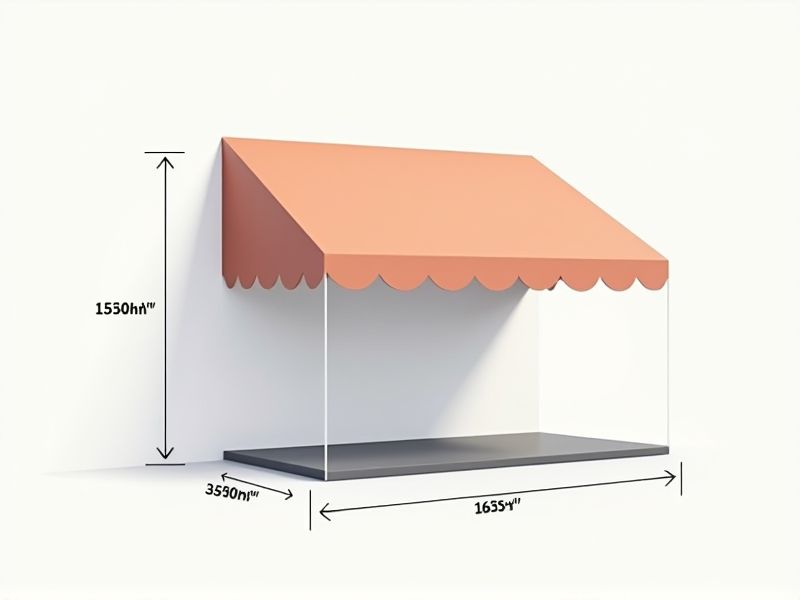
When considering an awning for your home or business, it's helpful to know the typical dimensions available. Standard widths usually range from 6 to 24 feet, while the projection (how far the awning extends outward) commonly falls between 2.5 to 13 feet. For example, a popular size for a residential patio might be 12 feet wide by 10 feet deep. Knowing these standard dimensions allows you to measure your space accurately and choose an awning size that fits both your needs and your budget.
Width
The standard width for residential awnings typically ranges from 5 to 16 feet, with custom options available to accommodate specific needs. Awnings should ideally extend at least 3 feet beyond the width of windows or entryways to provide adequate shading and protection. For patio awnings, a width of 12 to 18 feet is often recommended to cover spacious outdoor areas efficiently. When selecting your awning width, consider local climate conditions and sun exposure patterns to optimize functionality and aesthetic appeal.
Projection
The standard projection for awnings typically ranges from 4 to 10 feet, depending on the specific design and intended use. Awnings with a greater projection provide enhanced shade coverage, shielding your outdoor space from harmful UV rays by up to 98%. The ideal projection not only improves aesthetic appeal but also increases the functional area of patios and decks, making them more usable. When selecting an awning, consider both fixed and retractable options that meet your needs in terms of weather resistance and UV protection.
Height
The standard height for residential awnings typically ranges from 7 to 10 feet, ensuring adequate clearance for pedestrian traffic while maximizing shade. Commercial awnings may vary, often exceeding 10 feet to accommodate larger entrances and signage. Maintaining a minimum height of 7 feet is crucial for compliance with accessibility standards, providing a safe passage for all individuals. Consider your specific needs and location, as regional building codes may impose stricter regulations on awning height to enhance safety and aesthetic appeal.
Pitch
The pitch of an awning is critical for effective water runoff and optimal shade provision, typically ranging from 15 to 45 degrees. A steeper pitch enhances drainage, preventing water pooling, while a shallower angle can offer more shaded area but risks moisture accumulation. For residential awnings, a pitch of 30 degrees is often recommended to balance aesthetics and functionality. Understanding your awning's pitch can significantly impact its longevity and performance in various weather conditions.
Frame Size
When selecting an awning, the frame size is crucial for ensuring stability and functionality. A typical frame width ranges from 8 to 30 feet, accommodating various outdoor spaces. It's essential to consider that a well-sized frame can withstand wind speeds of up to 30 mph, providing protection against harsh weather conditions. For optimal performance, ensure the frame height allows for adequate clearance, usually between 7 to 9 feet, enhancing accessibility and usability for you and your guests.
Fabric Dimension
The standard awning fabric typically measures between 5 to 16 feet in width, allowing for versatile applications in residential and commercial spaces. You can choose from various materials, with popular options including acrylic, vinyl, and polyester, each offering different durability and UV resistance levels. It's crucial to consider a fabric weight, which usually ranges from 8 to 12 ounces per square yard, impacting both the longevity and performance of your awning. Furthermore, selecting the right color and pattern can enhance your building's aesthetics while providing functional shade and protection from the elements.
Mounting Height
The standard mounting height for awnings typically ranges from 7 to 8 feet, ensuring sufficient clearance for pedestrian traffic. This height facilitates unobstructed views for storefronts while providing shade and protection from the elements. For commercial applications, consider a mounting height of at least 8 feet to accommodate taller structures and signage visibility. In residential settings, you can adjust the height based on personal preference and the specific design of your outdoor space.
Arm Length
When selecting an awning, the arm length significantly influences shade coverage and functionality. Typical arm lengths range from 5 to 12 feet, allowing you to customize the projection based on your outdoor space. A longer arm can extend the awning further from the wall, providing more shade, while a shorter arm is ideal for compact areas. For optimal use, consider your specific needs, such as the area's sun exposure and your desired level of protection from UV rays.
Extension Length
The standard extension length for awnings typically ranges from 3 to 12 feet, depending on the specific design and intended use. For residential applications, a projection of 5 to 10 feet is commonly recommended to provide adequate shade over patios or decks. Commercial awnings may extend beyond 10 feet to maximize coverage for storefronts and outdoor dining areas. Choosing the right extension length ensures optimal protection from sun and rain, enhancing both comfort and usability.
Valance Size
The standard valance size for awnings typically ranges from 12 to 18 inches in height, providing not only aesthetic appeal but also functional shade control. When considering your awning, the valance plays a crucial role in blocking low sunlight and improving privacy. A properly sized valance can enhance outdoor comfort by reducing glare and protecting furniture from sun damage. For optimal results, you should measure your specific location to choose an awning that complements your space effectively.
